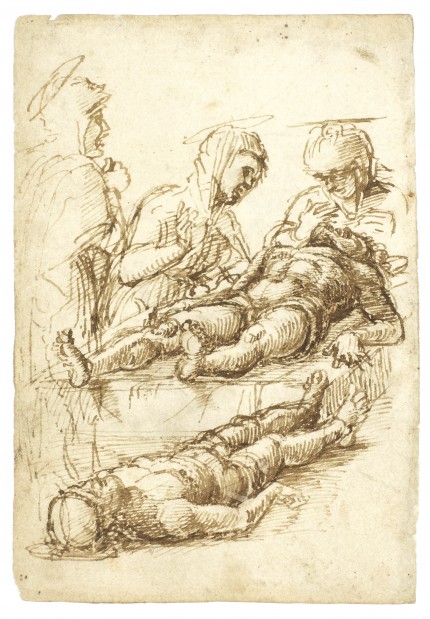
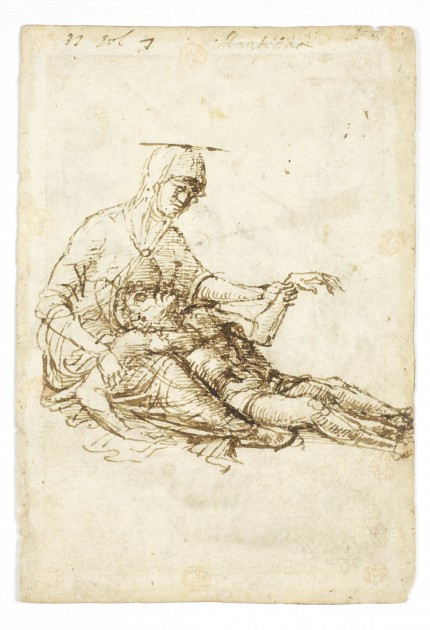
Going under the hammer today is an exceptional two-sided drawing by Renaissance master Andrea Mantegna (1431-1506). The pen and brown ink studies were discovered by appraisers from the Farsetti auction house in a folder of assorted prints and drawings belonging to a private collector in Tuscany. The owners had no idea they were by Mantegna and the drawings have never been published before so nobody else in the world even knew they existed.
Drawn on a small page of notebook paper just 151 millimeters (6 inches) high and 100 millimeters (4 inches) wide, the studies depict different scenes with the dead Christ. On the front side (aka the recto) is a Lamentation of the Christ. The body of Jesus lies on a marble bier while his mother Mary, Mary Magdalene and St. John the Apostle mourn over him. On the ground in front of the slab is another view of the dead Christ, this one lying in the opposite direction with his head closest to the viewer. On the back (verso) of the page is a Pietà, Mary cradling the body of her crucified son, holding his wrist almost as if she were checking for a pulse.
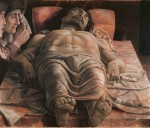 These drawings are very reminiscent of my favorite painting by Mantegna, the unique Lamentation over the Dead Christ, now in the Pinacoteca di Brera in Milan, which uses extreme perspective to emphasize Christ’s suffering and humanity. The figure of Christ is shockingly foreshortened, with his pierced feet in foreground, his pierced hands posed vertically so the ragged nail holes are in the viewer’s direct line of sight. His mother Mary, her face deeply lined with age, weeps beside him, but you can only see her face and hand. In front of her is St. John and he’s even more cropped with just a sliver of his face and a bit of his clasped hands visible. Behind Mary you can barely glimpse the mouth of another woman opened as if wailing in grief. This is Mary Magdalene, specifically identified by the presence of the unguent jar on the right back of Christ’s funerary slab.
These drawings are very reminiscent of my favorite painting by Mantegna, the unique Lamentation over the Dead Christ, now in the Pinacoteca di Brera in Milan, which uses extreme perspective to emphasize Christ’s suffering and humanity. The figure of Christ is shockingly foreshortened, with his pierced feet in foreground, his pierced hands posed vertically so the ragged nail holes are in the viewer’s direct line of sight. His mother Mary, her face deeply lined with age, weeps beside him, but you can only see her face and hand. In front of her is St. John and he’s even more cropped with just a sliver of his face and a bit of his clasped hands visible. Behind Mary you can barely glimpse the mouth of another woman opened as if wailing in grief. This is Mary Magdalene, specifically identified by the presence of the unguent jar on the right back of Christ’s funerary slab.
The body of Christ in newly discovered drawings, while not as extremely positioned, is angled backwards. Mantegna is playing with perspective in the recto, flipping the body around to see how it looks with the head in front. Notice also the hands, that quasi-verticle awkward angle which props the palms up on the fingers so the stigmata can be clearly seen. We don’t know when exactly Mantegna painted Lamentation over the Dead Christ but it was probably in the 1480s. The pen and ink studies date to around 1460, so they are considerably older and thus were probably not preparatory for the later masterpiece. They do illustrate the artist’s longstanding exploration of the subject, however.
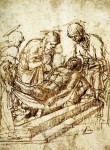 The attribution to Mantegna is unusually solid for an unpublished drawing, thanks to two features that connect it to another two-sided Mantegna pen and brown ink study now in the Pinacoteca Tosio Martinengo in Brescia, Lombardy. Written across the top of the Pietà side is the annotation “31 Vol 1 Mantegna.” The verso of the Brescia piece is inscribed “37 Vol 1 Mantegna” in the same handwriting and in the same position at the top of the page. Both versos also have the same marks along the
The attribution to Mantegna is unusually solid for an unpublished drawing, thanks to two features that connect it to another two-sided Mantegna pen and brown ink study now in the Pinacoteca Tosio Martinengo in Brescia, Lombardy. Written across the top of the Pietà side is the annotation “31 Vol 1 Mantegna.” The verso of the Brescia piece is inscribed “37 Vol 1 Mantegna” in the same handwriting and in the same position at the top of the page. Both versos also have the same marks along the 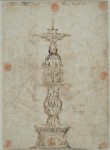 edges: red dots left by wax blobs used to affix the page into a notebook. There’s a thematic link as well. The recto of the Brescia drawing is a Burial of Christ wherein Mary Magdalene and St. John lower Jesus’ body into the grave while Mother Mary hunches over it praying. (The verso is unrelated, a study of an elaborate candlestick.) The writing and wax blobs strongly suggests these are two pages from the name notebook.
edges: red dots left by wax blobs used to affix the page into a notebook. There’s a thematic link as well. The recto of the Brescia drawing is a Burial of Christ wherein Mary Magdalene and St. John lower Jesus’ body into the grave while Mother Mary hunches over it praying. (The verso is unrelated, a study of an elaborate candlestick.) The writing and wax blobs strongly suggests these are two pages from the name notebook.
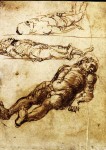 The British Museum has a third double-sided drawing by Mantegna which, while missing a handy annotation or wax remnants, serves as a useful comparison. Again the medium is pen and brown ink on paper, and again the subject is the dead Christ and his loved ones. The recto is three studies of Christ’s dead body lying on the ground (notice that hand position in the foreground Christ). The verso is two female saints praying on the ground.
The British Museum has a third double-sided drawing by Mantegna which, while missing a handy annotation or wax remnants, serves as a useful comparison. Again the medium is pen and brown ink on paper, and again the subject is the dead Christ and his loved ones. The recto is three studies of Christ’s dead body lying on the ground (notice that hand position in the foreground Christ). The verso is two female saints praying on the ground.
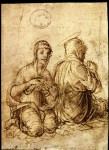 University of Leicester professor of Art History David Ekserdjian, who wrote the catalog for a 1992 Mantegna retrospective at the Royal Academy of Arts in London and the Metropolitan Museum in New York, examined the auction drawings in person. Because the Brescia and London works had been attributed to Giovanni Bellini, Mantegna’s brother-in-law and a highly influential artist of the Venetian school, by art historian Detlev Freiherr von Halden in 1925, Ekserdjian compared the Brescia drawings to the British Museum’s double-sided study and to another Mantegna drawing of a Pietà in the Galleria dell’Accademia in Venice to confirm the Mantegna
University of Leicester professor of Art History David Ekserdjian, who wrote the catalog for a 1992 Mantegna retrospective at the Royal Academy of Arts in London and the Metropolitan Museum in New York, examined the auction drawings in person. Because the Brescia and London works had been attributed to Giovanni Bellini, Mantegna’s brother-in-law and a highly influential artist of the Venetian school, by art historian Detlev Freiherr von Halden in 1925, Ekserdjian compared the Brescia drawings to the British Museum’s double-sided study and to another Mantegna drawing of a Pietà in the Galleria dell’Accademia in Venice to confirm the Mantegna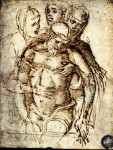 attribution for the 1992 exhibition. He believes all of these drawings, including the auction lot, are by the same hand and that that hand belonged to Andrea Mantegna. He has submitted a paper about his assessment, A New Drawing by Andrea Mantegna, to a journal and publication is pending.
attribution for the 1992 exhibition. He believes all of these drawings, including the auction lot, are by the same hand and that that hand belonged to Andrea Mantegna. He has submitted a paper about his assessment, A New Drawing by Andrea Mantegna, to a journal and publication is pending.
The pre-sale estimate was €140,000 ($187,558) to €220,000 ($294,734), very low for a museum-quality Old Master drawing. The auction house may have set it so low because there’s no way this work will get an export license — it’s pretty much the definition of irreplaceable cultural patrimony — which means deep pocketed overseas buyers aren’t as likely to bid.
UPDATE: The drawings sold for €420,000 ($562,674) hammer price, €509,650 ($682,778) including buyer’s premium. The buyer is an Italian private collector who chooses to remain anonymous.